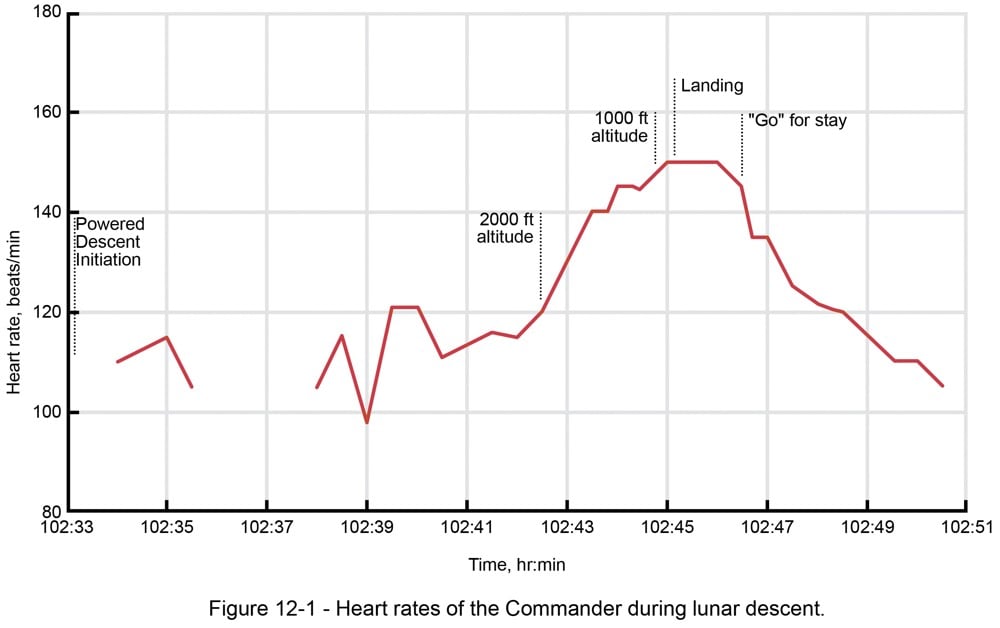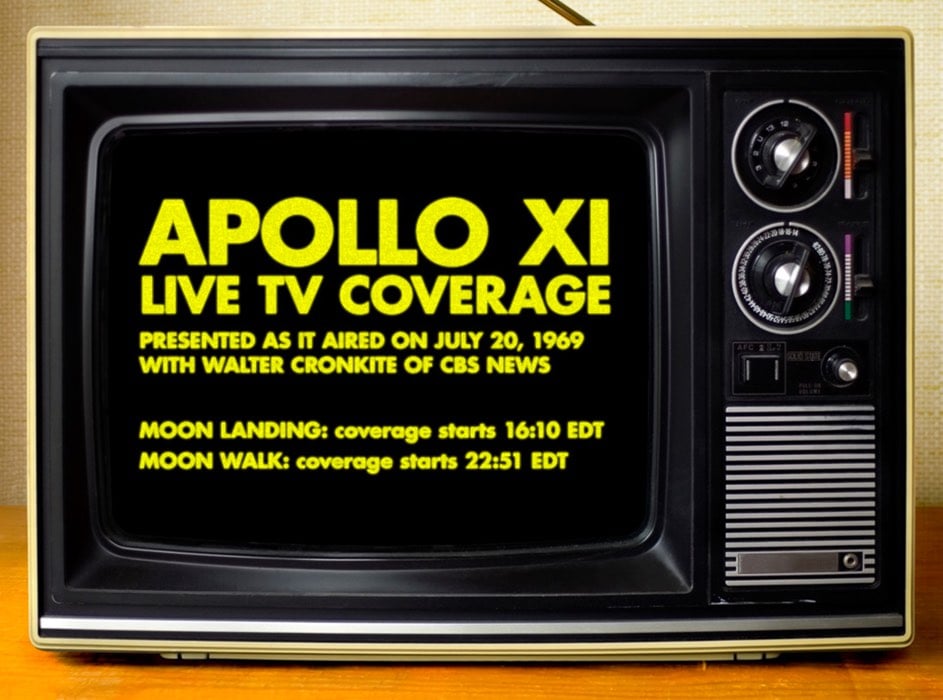Live TV coverage of the Apollo 11 landing and Moon walk
In May 1961, President John F. Kennedy stood before Congress and said:
I believe that this nation should commit itself to achieving the goal, before this decade is out, of landing a man on the moon and returning him safely to the earth.
A little more than 8 years later, it was done. On July 20, 1969, 49 years ago today, Neil Armstrong and Buzz Aldrin landed on the Moon, took a walk, and returned safely to Earth a few days later. And the whole thing was broadcast live on television screens around the world.
For the 40th anniversary of the landing in 2009, I put together a page where you can watch the original CBS News coverage of Walter Cronkite reporting on the Moon landing and the first Moon walk, synced to the present-day time. Just open this page in your browser and the coverage will start playing at the proper time. Here’s the schedule (all times EDT):
4:10:30 pm: Moon landing broadcast starts
4:17:40 pm: Lunar module lands on the Moon
4:20:15 pm: Break in coverage
10:51:27 pm: Moon walk broadcast starts
10:56:15 pm: First step on Moon
11:51:30 pm: Nixon speaks to the Eagle crew
12:00:30 am: Broadcast end (on July 21)
You can add these yearly recurring events to your calendar: Moon landing & Moon walk.
Here’s what I wrote when I launched the project, which is one of my favorite things I’ve ever done online:
If you’ve never seen this coverage, I urge you to watch at least the landing segment (~10 min.) and the first 10-20 minutes of the Moon walk. I hope that with the old time TV display and poor YouTube quality, you get a small sense of how someone 40 years ago might have experienced it. I’ve watched the whole thing a couple of times while putting this together and I’m struck by two things: 1) how it’s almost more amazing that hundreds of millions of people watched the first Moon walk *live* on TV than it is that they got to the Moon in the first place, and 2) that pretty much the sole purpose of the Apollo 11 Moon walk was to photograph it and broadcast it live back to Earth.
I’ve been listening to the audiobook of Andrew Chaikin’s account of the Apollo program, A Man on the Moon, and the chapter about Apollo 11’s Moon landing was riveting.1 I’ve watched the TV footage & listened to the recordings dozens of times and I was still on the edge of my seat, sweating the landing alongside Armstrong and Aldrin. And sweating they were…at least Armstrong was. Take a look at his heart rate during the landing; it peaked at 150 beats per minute at landing (note: the “1000 ft altitude” is mislabeled, it should be “100 ft”):

For reference, Armstrong’s resting heart rate was around 60 bpm. There are a couple of other interesting things about this chart. The first is the two minutes of missing data starting around 102:36. They were supposed to be 10 minutes from landing on the Moon and instead their link to Mission Control in Houston kept cutting out. Then there were the intermittent 1201 and 1202 program alarms, which neither the LM crew nor Houston had encountered in any of the training simulations. At the sign of the first alarm at 102:38:26, Armstrong’s heart rate actually appears to drop. And then, as the alarms continue throughout the sequence along with Houston’s assurances that the alarm is nothing to worry about, Armstrong’s heart rate stays steady.
Right around the 2000 feet mark, Armstrong realizes that he needs to maneuver around a crater and some rocks on the surface to reach a flat landing spot and his heart rate steadily rises until it plateaus at the landing. At the time, he thought he’d landed with less than 30 seconds of fuel remaining. That Neil Armstrong was able to keep his cool with unknown alarms going off while avoiding craters and boulders with very little fuel remaining and his heart rate spiking while skimming over the surface OF THE FREAKING MOON doing something no one had ever done before is one of the most totally cold-blooded & badass things anyone has ever done. Damn, I get goosebumps just reading about it!
Update: The landing broadcast just aired and I wanted to explain a little about what you saw (you can relive it here).
The shots of the Moon you see during the landing broadcast are animations…there is obviously no camera on the Moon watching the LM descend to the surface. There was a camera recording the landing from the LM but that footage was not released until later. This is in contrast to the footage you’ll see later on the Moon walk broadcast…that footage was piped in live to TV screens all over the world as it happened.
The radio voices you hear are mostly Mission Control in Houston (specifically Apollo astronaut Charlie Duke, who acted as the spacecraft communicator for this mission) and Buzz Aldrin, whose job during the landing was to keep an eye on the LM’s altitude and speed — you can hear him calling it out, “3 1/2 down, 220 feet, 13 forward.” Armstrong doesn’t say a whole lot…he’s busy flying and furiously searching for a suitable landing site. But it’s Armstrong that says after they land, “Houston, Tranquility Base here. The Eagle has landed.”. Note the change in call sign from “Eagle” to “Tranquility Base”. :)
Two things to listen for on the broadcast: the 1201/1202 program alarms I mentioned above and two quick callouts by Charlie Duke about the remaining fuel towards the end: “60 seconds” and “30 seconds”. Armstrong is taking all this information in through his earpiece — the 1202s, the altitude and speed from Aldrin, and the remaining fuel — and using it to figure out where to land.
The CBS animation shows the fake LM landing on the fake Moon before the actual landing — when Buzz says “contact light” and then “engine stop”. The animation was based on the scheduled landing time and evidently couldn’t be adjusted. The scheduled time was overshot because of the crater and boulders situation mentioned above.
Cronkite was joined on the program by former astronaut Wally Schirra. When Armstrong signaled they’d landed, Schirra can be seen dabbing his eyes and Cronkite looks a little misty as well as he rubs his hands together.
The book is read by Bronson Pinchot, who played Balki Bartokomous on the 80s sitcom Perfect Strangers. He is a fantastic audiobook narrator.↩






Stay Connected